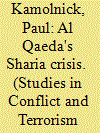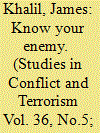|
|
|
Sort Order |
|
|
|
Items / Page
|
|
|
|
|
|
|
| Srl | Item |
| 1 |
ID:
122410


|
|
|
|
|
| Publication |
2013.
|
| Summary/Abstract |
Militant Islamist Sayyid Imam's legal critique of Al Qaeda's anti-U.S. mass casualty terrorism holds great potential utility for counterterrorist messaging strategy. In this article, a jihad-realist Islamist theological-jurisprudential methodology is first defended as the means most productive for delegitimizing Al Qaeda among high value, religiously motivated recruits. Second, Sayyid Imam's specific allegations and detailed Sharia proofs against Al Qaeda are presented. Finally, implications are drawn for U.S. counterterrorist messaging focusing especially on the utility of wielding this theological-juridical approach as compared to other "counternarrative" approaches, and the vital need to accurately characterize Islamism and its relation to terrorism.
|
|
|
|
|
|
|
|
|
|
|
|
|
|
|
|
| 2 |
ID:
122408


|
|
|
|
|
| Publication |
2013.
|
| Summary/Abstract |
How do jihadist insurgencies differ from non-jihadist ones? Jihadist insurgents, like all insurgents, seek to control the government, need money and weapons, and thrive where government is weak. Yet their cause-jihad at local, regional, and global levels-gives them instant friends and resources, but also built-in enemies and burdens. Jihadist insurgents often organize, recruit, and fund-raise differently than traditional insurgent groups. The agendas of these militant groups often go against the local residents' sense of nationalism and anger these communities with their extreme interpretations of Islam. To take advantage of this, the United States can amplify local voices that are best able to discredit these insurgents and press allied regimes to disrupt the mosques, schools, and fund-raising networks that help support them. However, Washington should also recognize that weakening these groups at the local level may make them more likely to embrace international terrorism. Allied efforts to co-opt jihadists may make area societies and governments less favorable to other U.S. policies. Finally, failed democratization-a particularly salient issue given the Arab Spring-risks playing into the jihadist narrative.
|
|
|
|
|
|
|
|
|
|
|
|
|
|
|
|
| 3 |
ID:
122411


|
|
|
|
|
| Publication |
2013.
|
| Summary/Abstract |
Academics and military analysts regularly attempt to distinguish terrorists from insurgents through focusing on the extent to which these adversaries (a) adopt nonviolent methods, (b) apply uncompromising forms of violence, (c) generate local support, (d) recruit and maintain manpower, and (e) control territory. In contrast, this article argues that attempts to distinguish between these adversaries inevitably fail, firstly, as they arbitrarily impose binary distinctions upon continuous variables (e.g., in levels of support, manpower figures), and secondly as there is a lack of agreement across these supposedly identifying characteristics. Thus, contrary to common wisdom, it is concluded that there is no contradiction in simultaneously labeling groups such as the Taliban and Al Qaeda as both terrorists and insurgents. Indeed, a complete understanding of these groups requires an assessment of their activities at both the tactical (as terrorists) and strategic (as insurgents) levels.
|
|
|
|
|
|
|
|
|
|
|
|
|
|
|
|
| 4 |
ID:
122409


|
|
|
|
|
| Publication |
2013.
|
| Summary/Abstract |
In internal ethno-territorial conflicts, what explains why state or rebel group leaderships use civilian-targeting strategies-expulsion or mass killing strategies designed to punish enemy civilians or to decimate the enemy civilian presence on contested territory? One argument is that those living under the worst initial conditions-defined in terms of collective goods such as weak collective autonomy, policy outcomes, and material conditions-are most likely to target enemy group civilians. Another approach focuses on relative power-arguing that the enemy civilian population is targeted either because of weaker or stronger relative power. A third approach argues that differences in leadership preferences-in particular, more ideologically extreme or power-seeking preferences-are likely to drive direct assaults on enemy civilians. We examine these proposed mechanisms in terms of expected effects on benefits and costs in a simple ethno-territorial bargaining framework. We argue that relative power advantages and more extreme nationalist preferences seem most likely to predict decisions to target enemy civilian populations. We expect strongly power-seeking preferences to lead to civilian targeting more conditionally-where there is a greater internal political threat along with either greater relative power or a more moderate enemy. Last, we do not expect that variation in initial conditions will have a significant direct effect. We apply the framework to explain patterns of civilian targeting following the collapse of Yugoslavia in 1991.
|
|
|
|
|
|
|
|
|
|
|
|
|
|
|
|
|
|
|
|
|